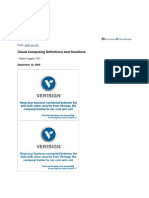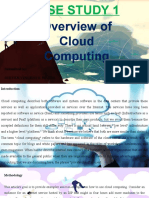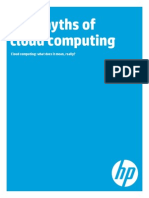Cloud Based Services
Cloud Based Services
Uploaded by
HalHagoodCopyright:
Available Formats
Cloud Based Services
Cloud Based Services
Uploaded by
HalHagoodOriginal Description:
Copyright
Available Formats
Share this document
Did you find this document useful?
Is this content inappropriate?
Copyright:
Available Formats
Cloud Based Services
Cloud Based Services
Uploaded by
HalHagoodCopyright:
Available Formats
Running head: CLOUD-BASED SERVICES
Cloud-Based Services
Hal Hagood
u07a1
Cloud Based Success Methodologies
CLOUD-BASED SERVICES
Could computing has made a movement from the utilization of physical equipment and privately
overseen programming and software to that of virtualized cloud-facilitated administration. Cloud
computing uses extensive systems of virtual services and administrations. This includes equipment (CPU,
network and storage) along with programming assets (databases, message frameworks, monitoring, and
load balancers). As Cloud keeps on revolutionizing applications in the educational community,
government, industry and numerous different fields, the move to this capable and adaptable platform
presents genuine difficulties at both hypothetical and down to earth levelsones that will frequently
require new methodologies and practices in all areas. A good example of Cloud success is given in the
case study of Mohawk Fine Papers.
JUST TWO WEEKS after Mohawk Fine Papers made the decision to sell its products on
Amazon.com, things were looking good for the company: Integration work was complete, connections to
its ERP system had lit up and sales were rolling in. Amazon generated tens of thousands of dollars in
revenue immediately, says Paul Stamas, vice president of IT at the $300 million, 725-employee
manufacturer of premium papers. Best of all, the data integration project, which cost less than $1,000 to
get off the ground, required no in-house investment in integration tools or staff resources.
Instead, cloud-services provider Liaison Technologies performed the integration work and then
set up -- and currently manages -- the connections through its cloud-based service. Two years ago, a
project like this would have been handled as just another point-to-point EDI integration. But the Amazon
deal and the 100-plus other business-to-business connections that Mohawk has set up through Liaison
over the past 18 months represent the culmination of Stamas' vision to create what he calls a serviceoriented architecture in the cloud (web.b.ebscohost.com, 2016).
Cloud-Based Failures
Two of the most spectacular failures I Cloud computing come from two well know names, Netflix
and Dropbox. One of the first real organizations to utilize Amazon's AWS cloud administrations was
Netflix. In many ways, the Netflix/AWS relationship was perfect: On the one hand, there was Netflix,
whose services were expanding far quicker than the organization could keep up with. On the other, retail
CLOUD-BASED SERVICES
monster Amazon was on the cutting edge of the distributed computing development and prepared to
make a dazzle everyone with its new pursuit. Sadly, the Netflix blackout, which occurred on Christmas
Eve, was so broadly promoted and affected such a variety of individuals that this single occasion
ostensibly set the whole undertaking cloud development back a few stages.
Dropbox permitted anybody to get to client information basically by entering an email location of
said client. No secret word was required. This enormous security stumble, brought about by a bug in a
code upgrade, did not last a few minutes, but rather for almost four hours before it was found and altered.
Advantages and Disadvantages of Cloud Computing
The advantages of Cloud computing are many including, cost savings, reliability, manageability
and completive edge. The disadvantages include downtime, security, vender lock in and limited control.
The cloud conundrum is a cause of common confusion for colocations and SMBs alike. Much
like a tongue twister, the benefits and drawbacks of cloud deployment can be hard to articulate even to
seasoned CIOs. So what are the cloud advantages for business and IT, and how worried should you be
about the disadvantages of cloud computing?
The cloud can bring value to your organization if the right software, platform or infrastructure is
deployed. Yet, before you downsize on premise IT for the service provider model, you need to understand
the features, benefits and limitations of the cloud.
The biggest fear of cloud computing is found in its major benefit the ability to outsource the IT
burden to a specialized vendor or provider. Sure it sounds great, but with a move to the cloud you do give
up the in-house control of a traditional IT department.
Probably the most understated benefit of the cloud it is reshaping IT into a proactively
innovative bunch that focuses a lot less on manual system administration, and a lot more on improving
the technology. From integration, mobility to even user personalization, giving your IT the cloud can make
their jobs much easier and more enjoyable (cloudcomputinginsights.com, 2016).
Best Practices for Extracting and Storing Data
CLOUD-BASED SERVICES
The market place for big data is a long way from full grown, however we now have quite a few
years of accumulated involvement with various best practices particular to big data. It's vital to remember
that there is a tried and true set of best practices created for relationally-based enterprise data
warehouses (EDWs) that can be used.
Drive the decision of information sources feeding the EDW from business needs
Focus constantly on client interface straightforwardness and execution
The following EDW best practices are particularly important to big data:
Think dimensionally: separate the world into measurements and certainties
Integrate separate information sources with confirmed measurements
Track time fluctuation with gradually evolving measurements (SCDs)
Anchor all measurements with solid surrogate keys
As of late, a significant part of the discussion around information administration has moved
toward the cloud as a low cost and profoundly adaptable arrangement that can be gotten to through any
web association. However, there are some genuine impediments to securing information in the cloud:
Overseeing records is your obligation. Cloud suppliers ordinarily won't be much help if there is a
glitch and you let them know.
Open clouds are multi-inhabitant, which implies if your "neighbor" has a security break, then your
information can be uncovered. Open clouds are often shabby and offer quick adaptability, yet
their shared segment implies especially touchy information ought to be kept in-house.
The cloud is, obviously, attached to web availability. In the event that you have an ISP blackout,
then you can't get to your cloud-based information. In the event that some of your data is totally
mission critical, then guarantee you have physical media reinforcements to help you maintain the
business on account of poor web connections.
Effects of Big Data and Cloud Storage
CLOUD-BASED SERVICES
The ascent of cloud computing and cloud information stores have been a forerunner and
facilitator to the rise of enormous information. Distributed computing is the commodification of processing
time and information stockpiling by method for institutionalized and standardized technologies. It has
critical advantages over more customary physical arrangements.
This prompts a situation for those responsible for big data ventures. How and which distributed
computing is the ideal decision for their computing needs, particularly if it is a major information venture?
These projects consistently show huge computing and capacity needs. In the meantime, business
partners and stakeholders expect quick, cheap, and tried and true solutions and task results.
Vertical scaling achieves elasticity by adding additional instances with each of them serving a
part of the demand. Software like Hadoop are specifically designed as distributed systems to take
advantage of vertical scaling. They process small independent tasks in massive parallel scale. Distributed
systems can also serve as data stores like NoSQL databases, e.g. Cassandra or HBase, or filesystems
like Hadoops HDFS. The interchangeability of the resources together with distributed software design
absorbs failure and equivalently scaling of virtual computing instances unperturbed. Spiking or bursting
demands can be accommodated just as well as personalities or continued growth.
Renting practically unlimited resources for short periods allows one-off or periodical projects at a
modest expense. Data mining and web crawling are great examples. It is conceivable to crawl huge web
sites with millions of pages in days or hours for a few hundred dollars or less. Inexpensive tiny virtual
instances with minimal CPU resources are ideal for this purpose since the majority of crawling the web is
spent waiting for IO resources. Instantiating thousands of these machines to achieve millions of requests
per day is easy and often costs less than a fraction of a cent per instance hour.
Of course, such mining operations should be mindful of the resources of the web sites or
application interfaces they mine, respect their terms, and not impede their service. A poorly planned data
mining operation is equivalent to a denial of service attack. Lastly, cloud computing is naturally a good fit
for storing and processing the big data accumulated form such operations (qubole.com, 2016).
References
CLOUD-BASED SERVICES
Cloudcomputinginsights.com, (2016). Cloud Computing Advantages and Disadvantages. Retrieved May
15, 2016 from http://www.cloudcomputinginsights.com/management/cloud-computingadvantages-and-disadvantages/?mode=featured
Qubole.com, (2016). Big Data Cloud Database & Computing. Retrieved May 15, 2016 from
http://www.cloudcomputinginsights.com/management/cloud-computing-advantages-anddisadvantages/?mode=featured
Web.b.ebschost, (2016). Integration in the Cloud. Retrieved May 15, 2016 from
http://web.b.ebscohost.com.library.capella.edu/ehost/detail/detail?sid=6a5c9f9b-cdea-4ca1-8538925368d270de
%40sessionmgr104&vid=0&hid=116&bdata=JnNpdGU9ZWhvc3QtbGl2ZSZzY29wZT1zaXRl#AN
=73516807&db=aph
You might also like
- Diversity in WorkplaceDocument43 pagesDiversity in WorkplaceRazin GajiwalaNo ratings yet
- Qumulo Cloud Migration GuideDocument27 pagesQumulo Cloud Migration Guideyassinyassin100% (1)
- Map Info For Telecom EngineersDocument5 pagesMap Info For Telecom EngineersUmar Abbas BabarNo ratings yet
- Main PaperDocument8 pagesMain PaperMilan JoshiNo ratings yet
- Top 7 Most Common Uses of Cloud Computing - IBM BlogDocument6 pagesTop 7 Most Common Uses of Cloud Computing - IBM Blogjose maldonadoNo ratings yet
- How Databases Can Meet The Demands of Cloud ComputingDocument6 pagesHow Databases Can Meet The Demands of Cloud ComputingmissshraddhasatpathyNo ratings yet
- A Study of Cloud Computing MethodologyDocument5 pagesA Study of Cloud Computing MethodologyR Dharshini SreeNo ratings yet
- Cloud Computing Is A General Term For Anything That Involves Delivering Hosted Services Over The InternetDocument14 pagesCloud Computing Is A General Term For Anything That Involves Delivering Hosted Services Over The InternetKh Aasim BashirNo ratings yet
- Cloud ComputingDocument20 pagesCloud ComputingانجنیرخرمNo ratings yet
- Idc Executive Brief: Cloud Computing in The Midmarket: Assessing The OptionsDocument7 pagesIdc Executive Brief: Cloud Computing in The Midmarket: Assessing The OptionsBiodor BonifacioNo ratings yet
- Application of Cloud ComputingDocument17 pagesApplication of Cloud ComputingPreetika SastryNo ratings yet
- KMBN It04 - Unit - 1Document19 pagesKMBN It04 - Unit - 1sumitrajput81720No ratings yet
- Cloud Computing Primer Ebook PDFDocument19 pagesCloud Computing Primer Ebook PDFgubdaNo ratings yet
- Cloud ComputingDocument5 pagesCloud ComputingkevmatinNo ratings yet
- Five Things To Know About Cloud Computing - Advanced Systems GroupDocument4 pagesFive Things To Know About Cloud Computing - Advanced Systems GroupJone SmithNo ratings yet
- Cloud Computing DocumentationDocument11 pagesCloud Computing DocumentationSailaja MannemNo ratings yet
- Cloud Computing: An: Executive SummaryDocument12 pagesCloud Computing: An: Executive SummaryshivieNo ratings yet
- Cloud ComputingDocument27 pagesCloud ComputingNehal GuptaNo ratings yet
- Cloud Computing Definitions and Solutions: FromDocument6 pagesCloud Computing Definitions and Solutions: FromRajesh SaxenaNo ratings yet
- Cloud Computing Correctd VersionDocument9 pagesCloud Computing Correctd VersionHafsa JehangirNo ratings yet
- A Project Report On Evaluating Benefits and Challenges of Cloud Computing Adoption in OrganizationDocument88 pagesA Project Report On Evaluating Benefits and Challenges of Cloud Computing Adoption in Organizationaurorashiva1No ratings yet
- Cloud ComputingDocument16 pagesCloud ComputingEesha Mushtaq 1422-FMS/BBAIT/S20No ratings yet
- Cloud ComputingDocument5 pagesCloud ComputinghimanshuNo ratings yet
- Cloud ComputingDocument6 pagesCloud ComputingTrisha ServitoNo ratings yet
- Cloud ComputingDocument8 pagesCloud ComputingsweetgirlieNo ratings yet
- Cloud Computing Term PaperDocument8 pagesCloud Computing Term Paperaflschrjx100% (1)
- CC Unit - 3Document36 pagesCC Unit - 3LavanyaDoopatiNo ratings yet
- (C - .-C - C-C (C: University of IdahocDocument9 pages(C - .-C - C-C (C: University of IdahocIndrani PeddakotlaNo ratings yet
- DocumentationDocument67 pagesDocumentationSurya Satya NikhilNo ratings yet
- Lecture1 CloudComputingDocument23 pagesLecture1 CloudComputingdarbha91No ratings yet
- Capturing The Value of Cloud ComputingDocument10 pagesCapturing The Value of Cloud ComputingAhmer SiddiquiNo ratings yet
- Cloud Computing - CloudonomicsDocument44 pagesCloud Computing - Cloudonomicsyaya yahuNo ratings yet
- Synopsis Cloud 3Document30 pagesSynopsis Cloud 3Priyanka LalNo ratings yet
- Cloud ComputingDocument10 pagesCloud ComputingSteven Vincent Flores PradoNo ratings yet
- Cloud Computing-2023Document34 pagesCloud Computing-2023Nakayiwa004 Sylvia (Sylvia Trish)No ratings yet
- 1 Running Head: CLOUD COMPUTINGDocument9 pages1 Running Head: CLOUD COMPUTINGRavi KaranamNo ratings yet
- Assignment No.:01: Course Title: Cloud Computing Submitted By: Sabera Sultana (1803003)Document11 pagesAssignment No.:01: Course Title: Cloud Computing Submitted By: Sabera Sultana (1803003)MD Monowar Ul IslamNo ratings yet
- Green Cloud Computing: D.Subashini and G.R.PratheekshaDocument9 pagesGreen Cloud Computing: D.Subashini and G.R.PratheekshapratheeksharaviNo ratings yet
- Cloud Computing For Financial Institutions: Vivek KejriwalDocument9 pagesCloud Computing For Financial Institutions: Vivek KejriwalPriyanka DhawanNo ratings yet
- Why Companies Are Leaving The CloudDocument2 pagesWhy Companies Are Leaving The Cloudleandro.carp75No ratings yet
- Stable Cloud Federations in The Sky: Formation Game and MechanismDocument9 pagesStable Cloud Federations in The Sky: Formation Game and MechanismISAR-PublicationsNo ratings yet
- Cloud Computing in Large Enterprises - Questions For The C-SuiteDocument5 pagesCloud Computing in Large Enterprises - Questions For The C-SuiteAparna Nayyar GoelNo ratings yet
- Research Paper On Cloud Computing ApplicationsDocument6 pagesResearch Paper On Cloud Computing Applicationsh04pn7zr100% (1)
- Analyst Report: Cloudify From GigaSpaces - Delivering Mission-Critical Applications To The Cloud at The Speed of BusinessDocument17 pagesAnalyst Report: Cloudify From GigaSpaces - Delivering Mission-Critical Applications To The Cloud at The Speed of Businessshar1zNo ratings yet
- Cloud Computing4Document10 pagesCloud Computing4Ibad RajaNo ratings yet
- CLOUD COMPUTING (WWW - Ebookmaterials.blogspot - Com)Document7 pagesCLOUD COMPUTING (WWW - Ebookmaterials.blogspot - Com)Mis MaliNo ratings yet
- ModelsDocument22 pagesModelsT neezy k OfficialNo ratings yet
- Assignment Cloud ComputingDocument13 pagesAssignment Cloud ComputingilovesomeoneNo ratings yet
- Cloud Connect: Charting The Course of On-Demand ComputingDocument11 pagesCloud Connect: Charting The Course of On-Demand ComputingArmandoNo ratings yet
- Cloud Computing1Document32 pagesCloud Computing1NiharikaNo ratings yet
- Five Myths of Cloud ComputingDocument8 pagesFive Myths of Cloud Computingdangkuw5572No ratings yet
- Cloud ComputingDocument7 pagesCloud ComputingHanan BinsalehNo ratings yet
- Research Paper On Hybrid Cloud ComputingDocument7 pagesResearch Paper On Hybrid Cloud Computinggz9fk0td100% (1)
- Cloud Computing: Sreenivasa Institute of Technology and Management Studies Chittoor-515217Document16 pagesCloud Computing: Sreenivasa Institute of Technology and Management Studies Chittoor-515217Siddhu SiddarthaNo ratings yet
- Cloud Computing FundamentalsDocument9 pagesCloud Computing FundamentalsBalabharathi SrinivasanNo ratings yet
- Cloud ComputingDocument2 pagesCloud ComputingKathlene BalicoNo ratings yet
- Moving Your Business to the Cloud (A Guide for Business People Shifting to eCommerce)From EverandMoving Your Business to the Cloud (A Guide for Business People Shifting to eCommerce)No ratings yet
- Cloud computing: Moving IT out of the officeFrom EverandCloud computing: Moving IT out of the officeBCS, The Chartered Institute for ITNo ratings yet
- Cloud Computing and Virtualization: Streamlining Your IT InfrastructureFrom EverandCloud Computing and Virtualization: Streamlining Your IT InfrastructureNo ratings yet
- U09a1 GRAPHICAL INFORMATION Hal HagoodDocument16 pagesU09a1 GRAPHICAL INFORMATION Hal HagoodHalHagoodNo ratings yet
- U10a1 DATA ANALYTICS INTERNSHIP TEXT MINING APPLICATIONS Hal Hagood Dante DurrmanDocument8 pagesU10a1 DATA ANALYTICS INTERNSHIP TEXT MINING APPLICATIONS Hal Hagood Dante DurrmanHalHagoodNo ratings yet
- U05a1 CLASSIFICATION METHOD Hal HagoodDocument9 pagesU05a1 CLASSIFICATION METHOD Hal HagoodHalHagoodNo ratings yet
- U04a2 DATA ANALYTICS INTERNSHIP Hal HagoodDocument7 pagesU04a2 DATA ANALYTICS INTERNSHIP Hal HagoodHalHagoodNo ratings yet
- U03a1 Analytics Internship Executive Summary 1 Group Hal HagoodDocument9 pagesU03a1 Analytics Internship Executive Summary 1 Group Hal HagoodHalHagoodNo ratings yet
- U01a1-Lan Infrastructure Deployment Scope-HagoodDocument10 pagesU01a1-Lan Infrastructure Deployment Scope-HagoodHalHagoodNo ratings yet
- Test 25: Machine Shop PracticeDocument51 pagesTest 25: Machine Shop PracticeNiaz KilamNo ratings yet
- SW-3510 Application - Guide - Rls - 4.0.3 NORTEL PDFDocument345 pagesSW-3510 Application - Guide - Rls - 4.0.3 NORTEL PDFNelson MorenoNo ratings yet
- Mountaintop Christian Academy Muntinlupa Grade 1 4th Quarter ExaminationDocument2 pagesMountaintop Christian Academy Muntinlupa Grade 1 4th Quarter ExaminationJhodie Anne IsorenaNo ratings yet
- 2008 Nissan Teana J32 Service Manual-DefDocument66 pages2008 Nissan Teana J32 Service Manual-DefMrihex100% (1)
- The Evolution of Glass Façades - Aleksander T. ŚwiątekDocument10 pagesThe Evolution of Glass Façades - Aleksander T. ŚwiątekAlexSaszaNo ratings yet
- Boiler Start-Up & Shut-DownDocument42 pagesBoiler Start-Up & Shut-DownBurhan Khan100% (3)
- Electrical SpecificationDocument121 pagesElectrical Specificationmritsoudis100% (2)
- Battery & Battery Chargers: (A Condensed Version For Emti Students)Document24 pagesBattery & Battery Chargers: (A Condensed Version For Emti Students)vihaanNo ratings yet
- Steam Joint and Stationary Siphon - For Optimum Dryer PerformanceDocument4 pagesSteam Joint and Stationary Siphon - For Optimum Dryer PerformancevenkNo ratings yet
- Beam Moment Diagram TablesDocument2 pagesBeam Moment Diagram TablesVictor Alejandro Calderón GonzálezNo ratings yet
- (Wilmerding, 2001) Term Sheets & Valuations PDFDocument131 pages(Wilmerding, 2001) Term Sheets & Valuations PDFЕвгений ИстоминNo ratings yet
- Anegan Full Movie Download HD Kickasstoinstmanks PDFDocument3 pagesAnegan Full Movie Download HD Kickasstoinstmanks PDFJerry George Varghese KNo ratings yet
- 26 5614a Power Steel 305x200x84cm Oval Pool Set ManualDocument9 pages26 5614a Power Steel 305x200x84cm Oval Pool Set ManualJose Luis LeguiaNo ratings yet
- Balog-Balog Dam StudyDocument12 pagesBalog-Balog Dam StudyJohn Eugene FernandezNo ratings yet
- Greek Souvlaki - The Most Famous (And Delicious) FoodDocument3 pagesGreek Souvlaki - The Most Famous (And Delicious) FoodEvi84evakiNo ratings yet
- 2013 LED/LCD TV Engineering GuideDocument72 pages2013 LED/LCD TV Engineering GuideRivaldoNo ratings yet
- The ABC's of VSA: Using Failed Signals To Confirm: by Lauren SnedekerDocument21 pagesThe ABC's of VSA: Using Failed Signals To Confirm: by Lauren SnedekerKranti Prajapati100% (1)
- 290 570 Eminence Lab 12 More InfoDocument8 pages290 570 Eminence Lab 12 More Infobk1313No ratings yet
- Essay Article On Consumer Awareness Towards Food SafetyDocument4 pagesEssay Article On Consumer Awareness Towards Food SafetyMohd Faizal Bin AyobNo ratings yet
- Cut Strip en Final Web 01Document48 pagesCut Strip en Final Web 01coldhomeyNo ratings yet
- Laysa vs. COADocument2 pagesLaysa vs. COAasg_jingNo ratings yet
- ASTM D 1265 - 04 Standard Practice For Sampling Liquefied Petroleum (LP) Gases Manual Method.Document5 pagesASTM D 1265 - 04 Standard Practice For Sampling Liquefied Petroleum (LP) Gases Manual Method.Pham LanphuongNo ratings yet
- Quote PHQ-300H Balancing MachineDocument17 pagesQuote PHQ-300H Balancing MachineMechanicalEngineNo ratings yet
- Tenancy Agreement: Between The Landlord Suresh Sinnappu AND The Tenant XXXXXDocument8 pagesTenancy Agreement: Between The Landlord Suresh Sinnappu AND The Tenant XXXXXRubini VijayasuriarNo ratings yet
- TSM Harassment Investigation SummaryDocument2 pagesTSM Harassment Investigation SummarySamson AmoreNo ratings yet
- Voluntary Delisting: The Reasons BehindDocument3 pagesVoluntary Delisting: The Reasons BehindNaison Shingirai PfavayiNo ratings yet
- Resume CARLOESTARESDocument2 pagesResume CARLOESTARESmostafaNo ratings yet
- Food Sci and Tech - 2019 - Hygienic Engineering DesignDocument3 pagesFood Sci and Tech - 2019 - Hygienic Engineering DesignGS LiNo ratings yet































































































